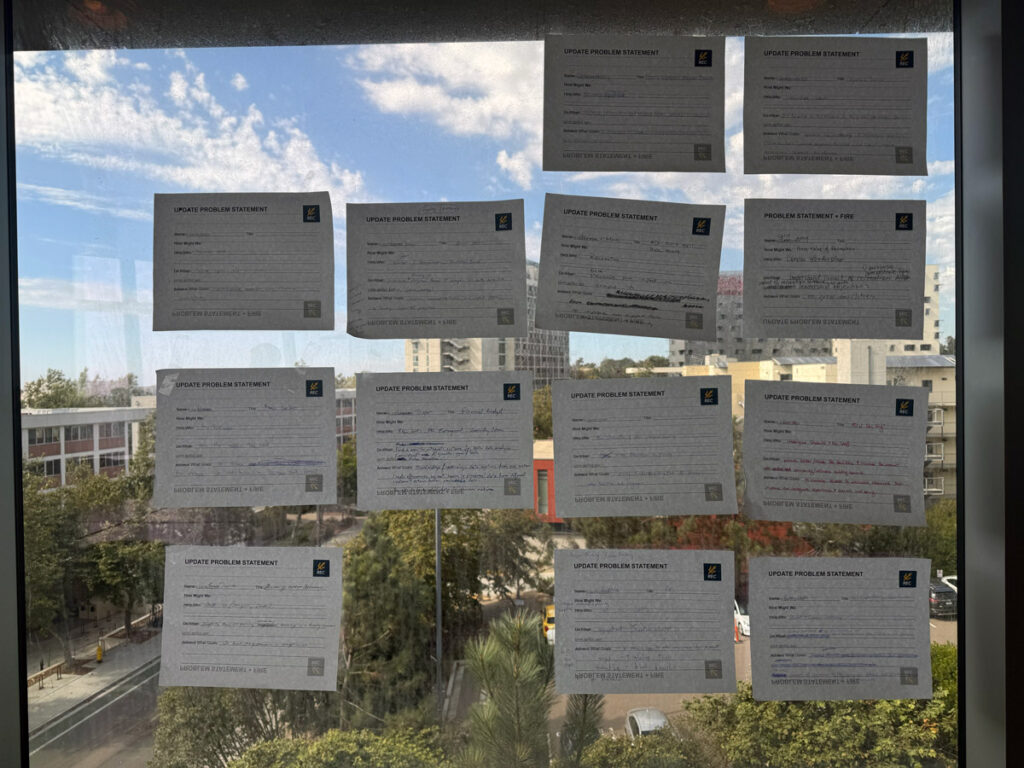The Recreation Department at UC San Diego hosted the first workshop in its strategic alignment initiative with the Recreation Department: From Problems to Problem Statements. Designed and led by Kevin Popovic, Education Manager of The Design Lab, this interactive session brought together 20 leadership members to define the department’s most pressing challenges and articulate them as actionable, measurable problem statements.
The workshop began with an inspiring introduction from Rich Mylin, who set the tone by encouraging participants to be candid in their discussions, emphasizing that no topic was off limits. His words fostered an atmosphere of openness, laying the groundwork for honest collaboration.
The Goal: From Problems to Problem Statements
This workshop was designed to help participants transform vague challenges into well-defined problem statements that:
- Detail what needs to be accomplished.
- Define the changes required.
- Establish measurable outcomes.
By focusing on clarity and specificity, the workshop aimed to provide a foundation for actionable solutions, ensuring that the department’s efforts align with UC San Diego’s broader goals outlined in the Student Affairs and Campus Life Strategic Plan (SACLSP).

The Outcomes: 13 Problem Statements
After extensive discussion and collaboration, the leadership team produced 13 priority problem statements across four thematic areas:
Priority 1: Culture and Communication
- How might we help Recreation Staff define and improve culture and communication to improve employee satisfaction scores and increase productivity?
- How might we help Rec Employees gain the resources they need to increase job satisfaction and decrease burnout?
- How might we help Struggling Staff complete their UC-mandated learning trainings in a timely manner so they remain in compliance?
Priority 2: Funding and Systems
4. How might we help Directors, Administration, and the Rec Board prioritize funding of programs based on analysis of costs, need, and resources to improve the current situation and impact future funding decisions?
5. How might we help Rec Units, Management, and University Admins integrate systems for better data analysis and consistent use of tools to make better decisions, centralize data capture, create efficiencies, and foster predictable data?
Priority 3: Campus Recognition and Engagement
6. How might we help Rec Leadership increase recognition and respect from campus leadership to secure additional resources like funding and facilities?
7. How might we help Recreation better showcase its impact on campus life to improve support from the campus community?
8. How might we help the Chancellor and other campus leaders make recreation a priority by raising funds and investing in new facilities and programs?
9. How might we help all Rec users engage in and buy into recreation activities to create more room for students, address management challenges, and improve funding and KPIs?
Priority 4: Facilities Expansion
10. How might we help undergraduate students put forth a referendum to build new recreation spaces to increase square footage, eliminate lines, enhance programs, reduce waitlists, and improve student satisfaction?
11. How might we help campus leadership recognize the impact of recreation and its alignment with leadership objectives to grow facilities?
12. How might we help undergraduate students and Rec staff provide better/newer Rec facilities and increase centralized community/wellness spaces to improve access to wellness resources and the overall collegiate experience?
13. How might we help students and campus leadership understand the importance of new recreational facilities to increase programs, improve student group reservations, and meet the growing needs of the UCSD community?

What’s Next?
The insights gathered from this workshop will guide the next step: a Management Workshop focused on refining these problem statements into actionable plans. By aligning these priorities with the university’s strategic plan, the Recreation Department is setting the stage for transformational change.
This workshop highlights the power of design thinking in addressing complex organizational challenges. Stay tuned as we continue to support UC San Diego Recreation in their journey to make a greater impact on campus life!

